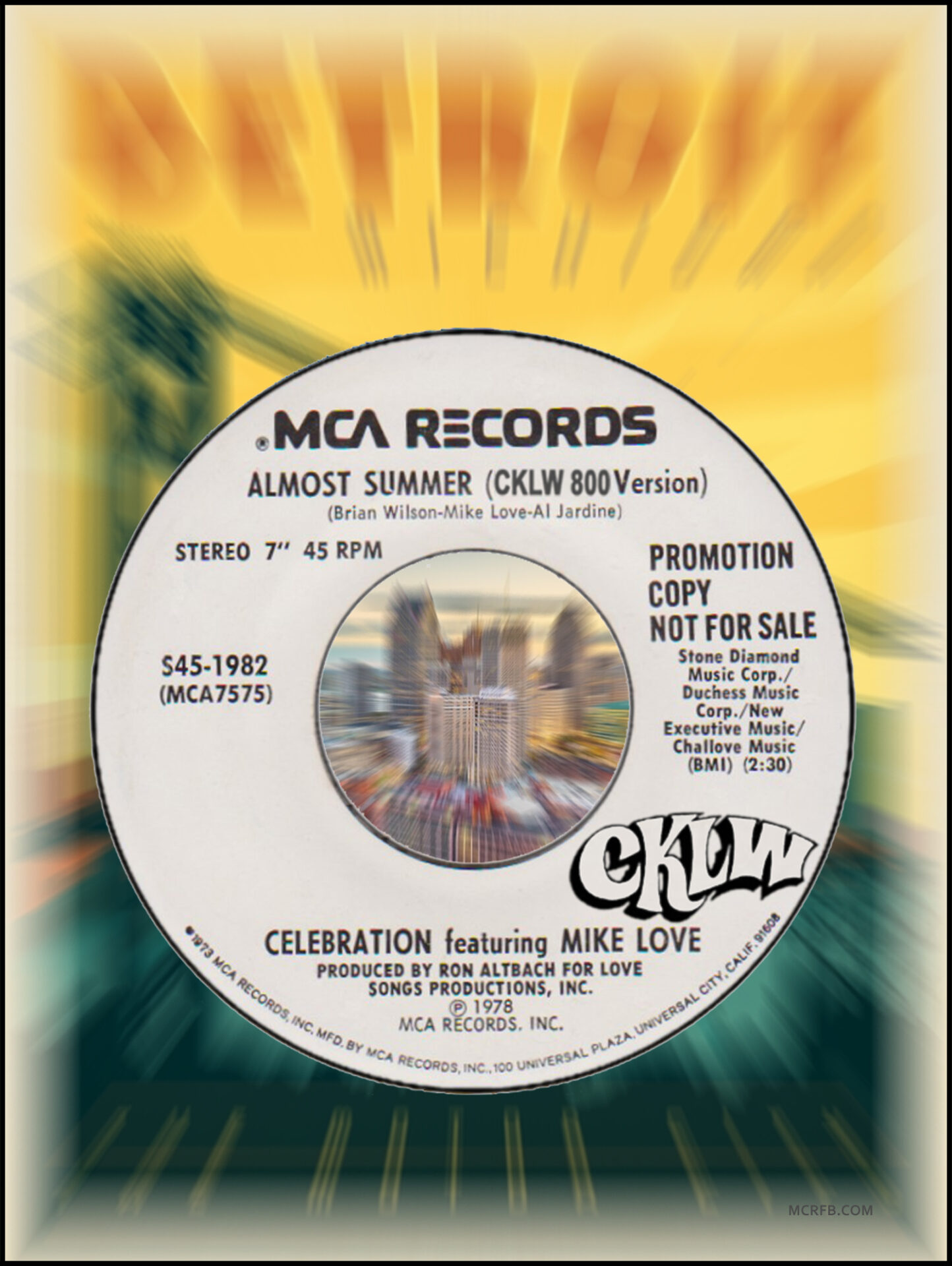
![]()
 Audio digitally enhanced by Motor City Radio Flashbacks
Audio digitally enhanced by Motor City Radio Flashbacks
![]()
![]() Normandy landings were the landing operations on Tuesday, 6 June 1944 of the Allied invasion of Normandy in Operation Overlord during World War II. Code named Operation Neptune and often referred to as D-Day, it was the largest seaborne invasion in history. The operation began the liberation of German-occupied France (and later Europe) from Nazi control, and laid the foundations of the Allied victory on the Western Front.
Normandy landings were the landing operations on Tuesday, 6 June 1944 of the Allied invasion of Normandy in Operation Overlord during World War II. Code named Operation Neptune and often referred to as D-Day, it was the largest seaborne invasion in history. The operation began the liberation of German-occupied France (and later Europe) from Nazi control, and laid the foundations of the Allied victory on the Western Front.
![]() Planning for the operation began in 1943. In the months leading up to the invasion, the Allies conducted a substantial military deception, code named Operation Bodyguard, to mislead the Germans as to the date and location of the main Allied landings. The weather on D-Day was far from ideal and the operation had to be delayed 24 hours; a further postponement would have meant a delay of at least two weeks as the invasion planners had requirements for the phase of the moon, the tides, and the time of day that meant only a few days each month were deemed suitable. Adolf Hitler placed German Field Marshal Erwin Rommel in command of German forces and of developing fortifications along the Atlantic Wall in anticipation of an Allied invasion.
Planning for the operation began in 1943. In the months leading up to the invasion, the Allies conducted a substantial military deception, code named Operation Bodyguard, to mislead the Germans as to the date and location of the main Allied landings. The weather on D-Day was far from ideal and the operation had to be delayed 24 hours; a further postponement would have meant a delay of at least two weeks as the invasion planners had requirements for the phase of the moon, the tides, and the time of day that meant only a few days each month were deemed suitable. Adolf Hitler placed German Field Marshal Erwin Rommel in command of German forces and of developing fortifications along the Atlantic Wall in anticipation of an Allied invasion.
![]() The amphibious landings were preceded by extensive aerial and naval bombardment and an airborne assault—the landing of 24,000 US, British, and Canadian airborne troops shortly after midnight. Allied infantry and armoured divisions began landing on the coast of France at 06:30. The target 50-mile (80 km) stretch of the Normandy coast was divided into five sectors: Utah, Omaha, Gold, Juno, and Sword. Strong winds blew the landing craft east of their intended positions, particularly at Utah and Omaha. The men landed under heavy fire from gun emplacements overlooking the beaches, and the shore was mined and covered with obstacles such as wooden stakes, metal tripods, and barbed wire, making the work of the beach-clearing teams difficult and dangerous. Casualties were heaviest at Omaha, with its high cliffs. At Gold, Juno, and Sword, several fortified towns were cleared in house-to-house fighting, and two major gun emplacements at Gold were disabled, using specialized tanks.
The amphibious landings were preceded by extensive aerial and naval bombardment and an airborne assault—the landing of 24,000 US, British, and Canadian airborne troops shortly after midnight. Allied infantry and armoured divisions began landing on the coast of France at 06:30. The target 50-mile (80 km) stretch of the Normandy coast was divided into five sectors: Utah, Omaha, Gold, Juno, and Sword. Strong winds blew the landing craft east of their intended positions, particularly at Utah and Omaha. The men landed under heavy fire from gun emplacements overlooking the beaches, and the shore was mined and covered with obstacles such as wooden stakes, metal tripods, and barbed wire, making the work of the beach-clearing teams difficult and dangerous. Casualties were heaviest at Omaha, with its high cliffs. At Gold, Juno, and Sword, several fortified towns were cleared in house-to-house fighting, and two major gun emplacements at Gold were disabled, using specialized tanks.
![]() The Allies failed to achieve any of their goals on the first day. Carentan, St. Lô, and Bayeux remained in German hands, and Caen, a major objective, was not captured until 21 July. Only two of the beaches (Juno and Gold) were linked on the first day, and all five beachheads were not connected until 12 June; however, the operation gained a foothold which the Allies gradually expanded over the coming months. German casualties on D-Day have been estimated at 4,000 to 9,000 men. Allied casualties were at least 10,000, with 4,414 confirmed dead.
The Allies failed to achieve any of their goals on the first day. Carentan, St. Lô, and Bayeux remained in German hands, and Caen, a major objective, was not captured until 21 July. Only two of the beaches (Juno and Gold) were linked on the first day, and all five beachheads were not connected until 12 June; however, the operation gained a foothold which the Allies gradually expanded over the coming months. German casualties on D-Day have been estimated at 4,000 to 9,000 men. Allied casualties were at least 10,000, with 4,414 confirmed dead.
![]() The Allies planned to launch the invasion on 1 May 1944. The initial draft of the plan was accepted at the Quebec Conference in August 1943. General Dwight D. Eisenhower was appointed commander of Supreme Headquarters Allied Expeditionary Force (SHAEF). General Bernard Montgomery was named as commander of the 21st Army Group, which comprised all land forces involved in the invasion. On 31 December 1943 Eisenhower and Montgomery first saw the plan, which proposed amphibious landings by three divisions with two more divisions in support. The two generals immediately insisted that the scale of the initial invasion be expanded to five divisions, with airborne descents by three additional divisions, to allow operations on a wider front and to speed the capture of Cherbourg. The need to acquire or produce extra landing craft for the expanded operation meant that the invasion had to be delayed to June. Eventually, thirty-nine Allied divisions would be committed to the Battle of Normandy: twenty-two US, twelve British, three Canadian, one Polish, and one French, totalling over a million troops all under overall British command.
The Allies planned to launch the invasion on 1 May 1944. The initial draft of the plan was accepted at the Quebec Conference in August 1943. General Dwight D. Eisenhower was appointed commander of Supreme Headquarters Allied Expeditionary Force (SHAEF). General Bernard Montgomery was named as commander of the 21st Army Group, which comprised all land forces involved in the invasion. On 31 December 1943 Eisenhower and Montgomery first saw the plan, which proposed amphibious landings by three divisions with two more divisions in support. The two generals immediately insisted that the scale of the initial invasion be expanded to five divisions, with airborne descents by three additional divisions, to allow operations on a wider front and to speed the capture of Cherbourg. The need to acquire or produce extra landing craft for the expanded operation meant that the invasion had to be delayed to June. Eventually, thirty-nine Allied divisions would be committed to the Battle of Normandy: twenty-two US, twelve British, three Canadian, one Polish, and one French, totalling over a million troops all under overall British command.
![]() The Normandy landings were the largest seaborne invasion in history, with nearly 5,000 landing and assault craft, 289 escort vessels, and 277 minesweepers participating. Nearly 160,000 troops crossed the English Channel on D-Day, with 875,000 men disembarking by the end of June. Allied casualties on the first day were at least 10,000, with 4,414 confirmed dead. The Germans lost 1,000 men. The Allied invasion plans had called for the capture of Carentan, St. Lô, Caen, and Bayeux on the first day, with all the beaches (other than Utah) linked with a front line 10 to 16 kilometres (6 to 10 mi) from the beaches; none of these objectives were achieved. The five beachheads were not connected until 12 June, by which time the Allies held a front around 97 kilometres (60 mi) long and 24 kilometres (15 mi) deep. Caen, a major objective, was still in German hands at the end of D-Day and would not be completely captured until 21 July. The Germans had ordered French civilians other than those deemed essential to the war effort to leave potential combat zones in Normandy. Civilian casualties on D-Day and D+1 are estimated at 3,000 people.
The Normandy landings were the largest seaborne invasion in history, with nearly 5,000 landing and assault craft, 289 escort vessels, and 277 minesweepers participating. Nearly 160,000 troops crossed the English Channel on D-Day, with 875,000 men disembarking by the end of June. Allied casualties on the first day were at least 10,000, with 4,414 confirmed dead. The Germans lost 1,000 men. The Allied invasion plans had called for the capture of Carentan, St. Lô, Caen, and Bayeux on the first day, with all the beaches (other than Utah) linked with a front line 10 to 16 kilometres (6 to 10 mi) from the beaches; none of these objectives were achieved. The five beachheads were not connected until 12 June, by which time the Allies held a front around 97 kilometres (60 mi) long and 24 kilometres (15 mi) deep. Caen, a major objective, was still in German hands at the end of D-Day and would not be completely captured until 21 July. The Germans had ordered French civilians other than those deemed essential to the war effort to leave potential combat zones in Normandy. Civilian casualties on D-Day and D+1 are estimated at 3,000 people.
Source, information and credit: D-Day Wikipedia
In the early morning hours of June 6, 1944, the CBS and NBC radio networks, centered in New York, took control of the day’s wartime news on all of their respective affiliated stations nationwide — special bulletins and all-day broadcasting of the reported allied invasion off the northern coast of France.
In 1944 the CBS Detroit affiliate was WWJ. The NBC Detroit (Blue Network) affiliate was WXYZ. These historic CBS (WWJ 950) and NBC (WXYZ 1270) broadcasts was heard in wartime Detroit over the radio, on this day, 80 years ago.
Audio portions for this presentation was selected from 24 continuous hours of these broadcasts (24 hours per network) we have in our archives. Today, Motor City Radio Flashbacks highlights the first three hours of the D-Day radio broadcasts as it was reported, respectively, on CBS and NBC radio, in the early-hours of Tuesday morning, June 6, 1944.
![]()
 On your mobile device? Tap over newspaper image. Open to second window. “Stretch” image across your device screen for digitized view.
On your mobile device? Tap over newspaper image. Open to second window. “Stretch” image across your device screen for digitized view.
On your PC? Click on the newspaper image 2x for detailed print view.
![]()
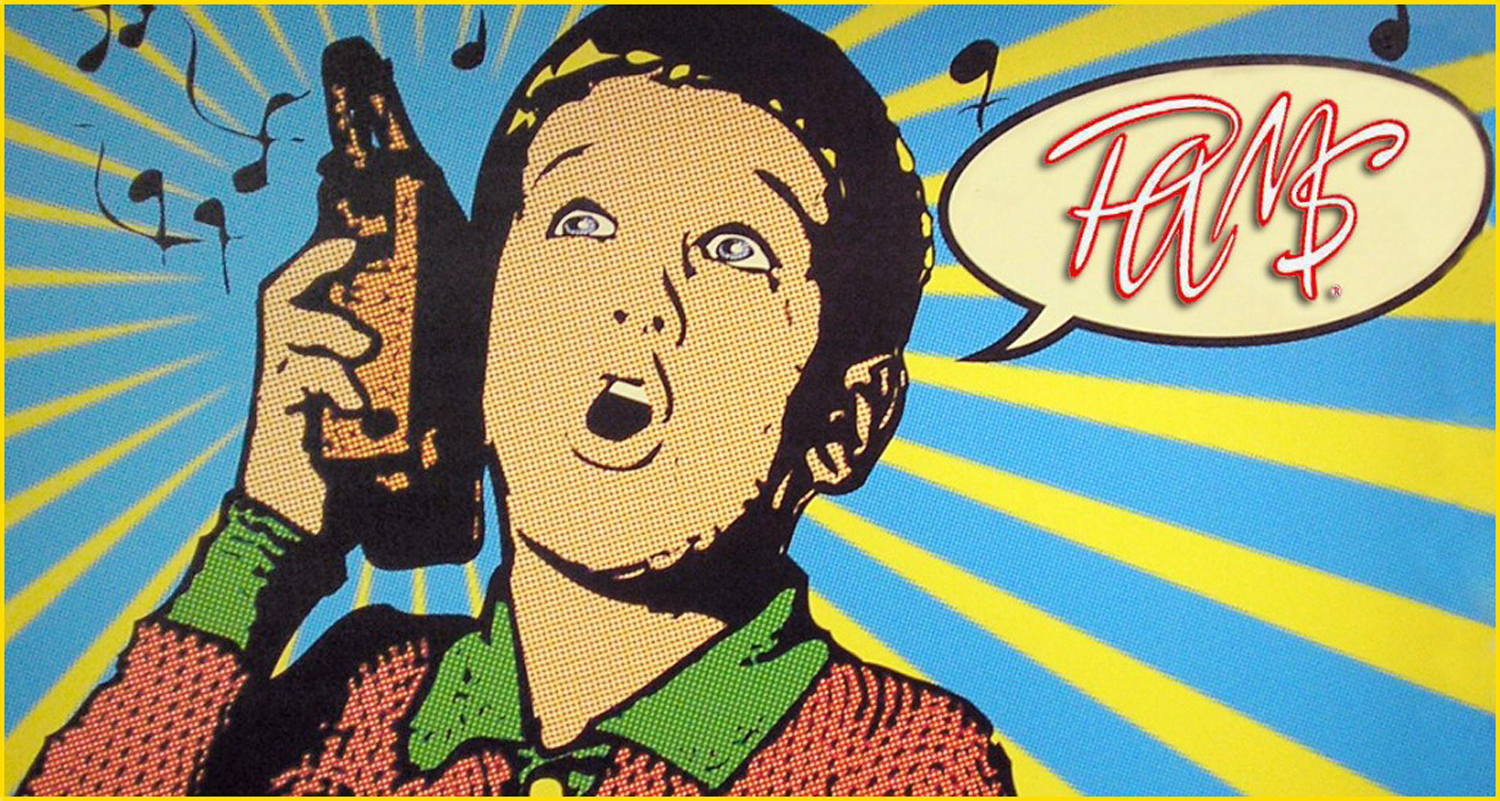
![]() Audio digitally remastered by Motor City Radio Flashbacks
Audio digitally remastered by Motor City Radio Flashbacks
 In 1971, WKNR-FM shifted from its progressive rock format to “Stereo Island,” a blend of Beautiful Music and Middle of the Road styles, foreshadowing what would later be known as Soft Adult Contemporary. This transition proved successful, inspiring others like WFMK in Lansing, Michigan. By early 1972, both WKNR and WKNR-FM were sold. On April 25, 1972, at 8:00 a.m., WKNR-FM bid farewell to the Stereo Island format, rebranding as WNIC and WNIC FM. They began simulcasting a straightforward Beautiful Music format, with the call letters “WNIC” chosen to reflect the station’s commitment to “NICe” music. In 1976, WNIC embraced (48 years ago) a more lively tone dubbed “Rock ‘n’ Easy,” eventually evolving into its current (and much successful) adult contemporary format, a status those same call letters still maintains today.
In 1971, WKNR-FM shifted from its progressive rock format to “Stereo Island,” a blend of Beautiful Music and Middle of the Road styles, foreshadowing what would later be known as Soft Adult Contemporary. This transition proved successful, inspiring others like WFMK in Lansing, Michigan. By early 1972, both WKNR and WKNR-FM were sold. On April 25, 1972, at 8:00 a.m., WKNR-FM bid farewell to the Stereo Island format, rebranding as WNIC and WNIC FM. They began simulcasting a straightforward Beautiful Music format, with the call letters “WNIC” chosen to reflect the station’s commitment to “NICe” music. In 1976, WNIC embraced (48 years ago) a more lively tone dubbed “Rock ‘n’ Easy,” eventually evolving into its current (and much successful) adult contemporary format, a status those same call letters still maintains today.
![]()
![]() Partial information, presented in this post, was obtained from credited source: WNIC Wikipedia
Partial information, presented in this post, was obtained from credited source: WNIC Wikipedia
![]() The featured WKNR Stereo Island Jingle PAMS package is licensed, property of JAM, Incorporated. The PAMS logo and brand is licensed and marketed by JAM Productions, Dallas.
The featured WKNR Stereo Island Jingle PAMS package is licensed, property of JAM, Incorporated. The PAMS logo and brand is licensed and marketed by JAM Productions, Dallas.
![]()
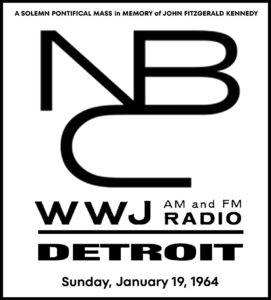 It could have been for no one else, for it was like the man. It had great dignity, great beauty, great style, great quality.
It could have been for no one else, for it was like the man. It had great dignity, great beauty, great style, great quality.
And it was done in the city that was proudest of him.
They were not all his friends, those who came. Some were But he would have known most of them by name, for they were a most distinguished group who climbed the steps of the Holy Cross Cathedral on the sun-drenched morning for the solemn pontifical Mass of requiem for John Fitzgerald Kennedy, celebrated by his friend, Cardinal Cushing, who beamed after the ceremony was over.
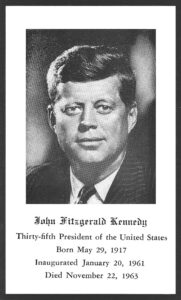 He would have liked to, the people who did not have tickets to a pew in the cathedral and who waited, nine deep, outside on Washington St. just to get a glimpse of his wife; his mother, Mrs. Rose Kennedy; his senator-brother, Edward, and the others.
He would have liked to, the people who did not have tickets to a pew in the cathedral and who waited, nine deep, outside on Washington St. just to get a glimpse of his wife; his mother, Mrs. Rose Kennedy; his senator-brother, Edward, and the others.
He would have had a special salute for them, that slight wave of the hand. And he would have smiled at the cardinal, who beamed after the ceremony was over, and said: “Haven’t I got a lot of nerve to sing along with those people.”
But as the Boston Symphony Orchestra director, Eric Leinsdorf, reminded the cardinal: “It’s the heart which counts, rather than the voice.”
John Kennedy was not what you would call a connoisseur of the musical classics. He liked music, and wherever he went as President he brought with him a phonograph that played nearly constantly in his room.
His selections of recordings was mostly those of his era, and some called them square. But he had fine taste.
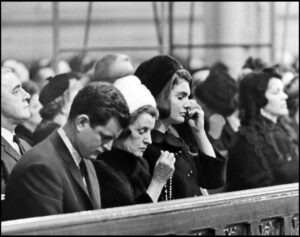
He would have appreciated the magnificent compositions of Mozart’s Requiem Mass in D Minor by the 55 musicians of the Boston Symphony Orchestra, the 180 voices of the three choral groups and the responses in the Mass by the seminarians from St. John’s.
He would have been pleased too, that his wife was pleased. He fully appreciated her taste in the classics. At the conclusion of the Mass she walked across the front of the church and thanked Leinsdorf. She called his work “magnificent.” This was the way it was in the church and on television — even for those with an untrained ear.
As one of the distinguished symphony patrons put it as he walked through the door of the cathedral at the conclusion of the Mass:
“I have never heard anything like it in any church, any place in the country.”
For th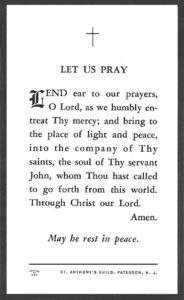 e Catholics who attend Mass every Sunday there had never been anything like it in this country either. The requiem had been performed in Vienna at St. Stephen’s Cathedral in 1956 on the 200th anniversary of Mozart’s birth, but it was the first time it had been done in a church in the United States — while millions watched the Mass on (NBC) television in their homes.
e Catholics who attend Mass every Sunday there had never been anything like it in this country either. The requiem had been performed in Vienna at St. Stephen’s Cathedral in 1956 on the 200th anniversary of Mozart’s birth, but it was the first time it had been done in a church in the United States — while millions watched the Mass on (NBC) television in their homes.
[Note: The NBC televised Mass (Detroit; WWJ-TV 4) was also simultaneously broadcast live over the NBC Radio Network, including WWJ-FM 97.1 in Detroit. The recorded audio is exclusively featured for this presentation, below.]
John F. Kennedy admired talent. It was why he opened the White House to it during his short administration.
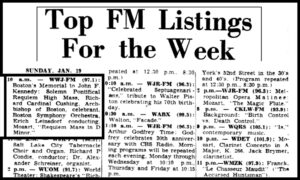
He told the Nobel Prize winners gathered in the great East Room one night that the White House had not seen such great talent since Thomas Jefferson dined there alone. It was another sad day who were close to John Kennedy –those who had worked next to him during the political campaigns and while he was President.
There was Cong. Torbert MacDonald, who was a close Harvard friend in college days and who served with him in Congress; there was former Senator Benjamin A. Smith, who worked the streets of Wisconsin and West Virginia during the 1960 primary campaigns, and there were Theodore Sorensen, who served as his right arm in the Senate and in the White House. Some of them, such as Sorensen, walked into the church virtually unnoticed by the people around them.
But as the cardinal said, there was a “beauty in this morning.”
_______________
![]()
![]() ______________________________
______________________________
Motor City Radio Flashbacks presents A Solemn Pontifical Requiem Mass in memory and in observance of the May 29, 1917 birth of John Fitzgerald Kennedy. One hundred and seven years ago, today.
The live broadcast aired on WWJ FM, Detroit, Sunday morning, 10 a.m., January 19, 1964.
Article featured published in the Boston Globe, Monday, January 20, 1964. Photo credit: Boston Globe
The John F. Kennedy Memorial prayer card (featured in the article) is from the Jim Feliciano collection.
_________________________________
 This January 19, 1964 NBC radio broadcast serves as our special tribute to President Kennedy’s memory, on this day, May 29, 2024. The program presented today, marks 60 years since the broadcast first aired. Having been in our archives for five years, we are featuring this recording for this occasion, and for the very first time.
This January 19, 1964 NBC radio broadcast serves as our special tribute to President Kennedy’s memory, on this day, May 29, 2024. The program presented today, marks 60 years since the broadcast first aired. Having been in our archives for five years, we are featuring this recording for this occasion, and for the very first time.
The Sunday, January 19, 1964, NBC television and radio broadcast was recorded at the Cathedral of the Holy Cross, Boston, Massachusetts, by RCA Victor. Recorded in stereo. RCA (see album cover at top) first released the recordings with a 2-LP record set — LSC-7030 — February 1964.
Produced by Richard Mohr. Recording engineered by Lewis Layton.
 ______________________________
______________________________
![]()
 NEW! A special THANK YOU to Mark Yurko, of Langhorne, PA., for his recent WKNR aircheck contribution for our Motor City Radio Flashbacks airchecks repository.
NEW! A special THANK YOU to Mark Yurko, of Langhorne, PA., for his recent WKNR aircheck contribution for our Motor City Radio Flashbacks airchecks repository.
A NOTE ABOUT STEVE CLARKE
Steve Clarke, who filled-in for Jim Jeffries (two weeks) in July 1966, was also a WKFR radio personality at Keener 14 in Battle Creek (also a Knorr station at the time). Since WKNR had another “Clark,” as in Ted Clark, the name Steve Clarke was dropped by WKNR management for Steve Robbins when hired to replace Jim Jeffries (who left WKNR for WQXI in Atlanta) before the end of 1967.
Newly restored! This audio recording was digitally enhanced by Motor City Radio Flashbacks.
![]()

![]()
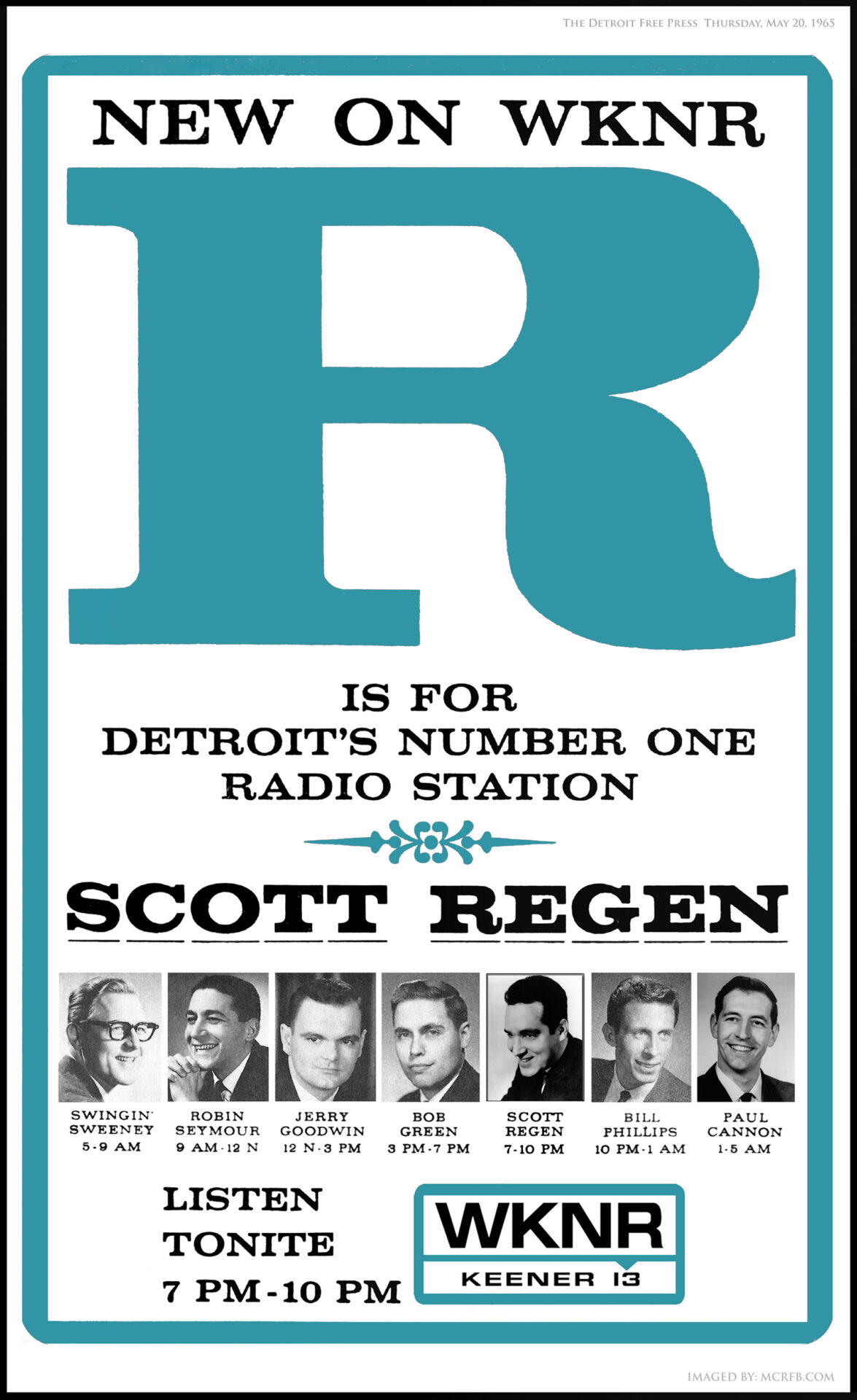
![]()
![]() Audio digitally remastered. Audio courtesy of Bob Green Productions
Audio digitally remastered. Audio courtesy of Bob Green Productions
This article/advertisement courtesy freep.com newspaper archive. Copyright 2024. Newspapers.com
Originally printed in black and white, the featured Detroit Free Press ad was digitally re-imaged, colorized, and was entirely restored by Motor City Radio Flashbacks.
Missed any previous ‘Detroit Radio Back-Pages‘ features? GO HERE
A special THANK YOU to WKNR legend Bob Green (Bob Green Productions) of Austin, Texas, for having shared with us, years ago, this May 1965 WKNR promo for our Motor City Radio Flashbacks archives.
Special THANKS to our friend, John Bartony (a.k.a. Jukebox John) St. Clair Shores, Michigan, for providing the above Detroit Free Press WKNR 1310 ad (May 20, 1965) for this site, as featured today.
 A special thank you to senior MCRFB consultant Greg Innis, of Livonia, MI., for contributing the Newspapers.com archives (Detroit radio related) articles, ads, and images we have provide for this site since 2016.
A special thank you to senior MCRFB consultant Greg Innis, of Livonia, MI., for contributing the Newspapers.com archives (Detroit radio related) articles, ads, and images we have provide for this site since 2016.
Thank you, Greg Innis, for making these historic Detroit radio features possible. 🙂

![]()
 ON YOUR PC? You can read this entire newsprint article/ad — the fine print — ENLARGED. For a larger detailed view click above image 2x and open to second window. Click image anytime to return to NORMAL image size.
ON YOUR PC? You can read this entire newsprint article/ad — the fine print — ENLARGED. For a larger detailed view click above image 2x and open to second window. Click image anytime to return to NORMAL image size.
Click your server’s back button to return to MCRFB.COM home page.
ON YOUR MOBILE DEVICE? Tap on newsprint image. Open to second window. “Stretch” image across your device screen to magnify for largest print view.

![]()